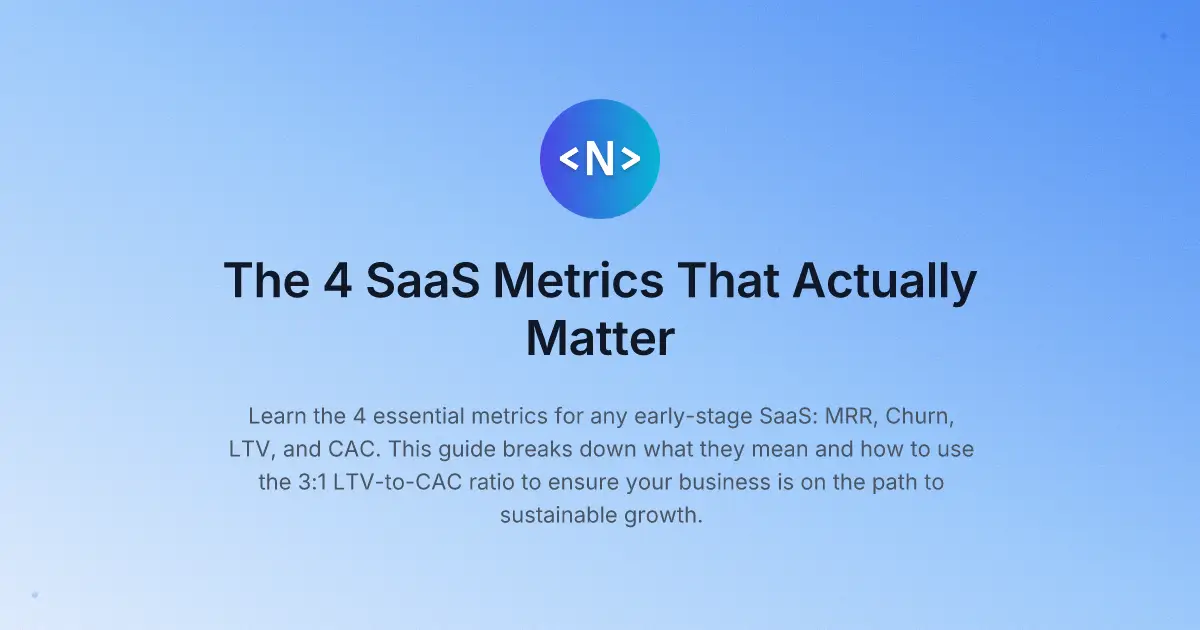Look, I get it. You're building a SaaS because you want to solve a real problem with code. You've got that entrepreneurial fire burning, and you're ready to change the world one subscription at a time.
But here's the thing – most founders are flying blind. They're obsessing over vanity metrics, building features nobody asked for, and burning through runway faster than a Formula 1 car burns through tires.
The difference between SaaS founders who make it and those who don't? They track the right metrics.
Not 47 different KPIs. Not some fancy dashboard that looks like mission control. Just four core metrics that actually tell you whether your business is healthy or heading for a cliff.
Let me break them down for you.
1. MRR (Monthly Recurring Revenue) – Your North Star
What it is: The predictable revenue your SaaS generates every month from paying customers.
Why it matters: MRR is the heartbeat of your business. It's what makes SaaS beautiful – predictable, recurring revenue that compounds over time. While your buddy's e-commerce store is playing feast-or-famine every month, you're building something that grows steadily.
A healthy MRR growth curve is the clearest signal you've got product-market fit. It's also what investors look at first when they're deciding whether to write you a check.
How to track it:
MRR = New MRR + Expansion MRR - Churned MRR - Contraction MRR
Focus on Net New MRR growth month-over-month. Is it positive? Is it accelerating? That's your signal.
2. Churn Rate – The Silent Killer
What it is: The percentage of customers who cancel their subscription each month.
Why it matters: High churn is a SaaS death sentence. Period. Think of your business like a leaky bucket – new customers are water flowing in, churn is the hole at the bottom. If that hole is too big, you'll never fill the bucket no matter how much you pour.
Here's the brutal truth: It costs 5-25x more to acquire a new customer than to keep an existing one. If you can't retain customers, you don't have a sustainable business.
How to track it:
Monthly Churn Rate = (Customers Lost This Month / Customers at Start of Month) × 100
Pro tip: Track revenue churn too. Losing a $500/month customer hurts way more than losing a $10/month customer.
The holy grail? Negative churn – when expansion revenue from existing customers exceeds revenue lost from churned customers.
3. LTV (Customer Lifetime Value) – Know Your Customer's Worth
What it is: The total revenue you'll generate from an average customer over their entire relationship with your company.
Why it matters: LTV answers the million-dollar question: "How much is a customer actually worth to me?" Without this number, you're making marketing decisions in the dark. How much should you spend on ads? What's your maximum sales budget? LTV gives you the answer.
How to calculate it:
LTV = Average Revenue Per User (ARPU) ÷ Monthly Churn Rate
Example: If your ARPU is $50/month and your monthly churn is 5%, your LTV is $1,000.
Notice how reducing churn dramatically increases LTV? That's why retention is so crucial.
4. CAC (Customer Acquisition Cost) – The Price of Growth
What it is: How much you spend in sales and marketing to acquire one new paying customer.
Why it matters: CAC tells you if your growth is sustainable or if you're just burning money. You might have impressive MRR growth, but if your CAC is too high, you're on a path to nowhere.
How to calculate it:
CAC = Total Sales & Marketing Spend ÷ Number of New Customers Acquired
Include everything: ad spend, salaries, tools, conferences – the whole nine yards.
The Golden Rule: LTV:CAC Ratio
Here's where it all comes together. These metrics mean nothing in isolation. The magic happens when you connect them.
Your LTV:CAC ratio is the ultimate health check for your SaaS.
- Less than 1:1 – You're in trouble. You're spending more to acquire customers than they're worth.
- 1:1 to 3:1 – You're breaking even to barely profitable. Not great.
- 3:1 – The sweet spot. For every dollar you spend on acquisition, you get three back.
- 5:1+ – Excellent, but maybe you're being too conservative. Consider investing more in growth.
The Reality Check
Now, here's the thing. You could spend the next 3 months building user authentication, setting up payment processing, configuring email systems, and handling all the other boring-but-necessary stuff that every SaaS needs.
Or you could use that time to talk to customers, reduce churn, and optimize your acquisition channels.
Which one sounds more valuable to your business?
This is exactly why I built Nexty. It's a Next.js SaaS boilerplate that comes with everything you need out of the box:
- ✅ Stripe payments integration
- ✅ Supabase authentication
- ✅ Email system with Resend
- ✅ Internationalization (i18n)
- ✅ AI integrations
- ✅ All the foundational infrastructure
Instead of spending months reinventing the wheel, you can launch your SaaS in days and focus on what actually moves the needle: building features your customers love and optimizing the metrics that matter.
Stop building boilerplate. Start building your business.
🚀 Check out nexty.dev and see how you can fast-track your SaaS journey.
